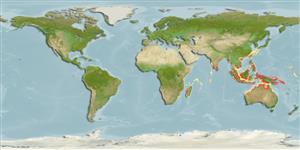Common names from other countries
Classification / Names / Names
Κοινά ονόματα | Συνώνυμα | Catalog of Fishes (gen., sp.) | ITIS | CoL | WoRMS
Environment: milieu / climate zone / depth range / distribution range
Οικολογία
; εύρος βάθους 7 - 90 m (Ref. 3175). Tropical
Indo-West Pacific.
Length at first maturity / Μέγεθος / Βάρος / Age
Maturity: Lm ? range ? - ? cm Max length : 8.3 cm CW αρσενικό/απροσδιόριστο; (Ref. 343); 7 cm CW (female)
Carapace rounded, much wider than long; surface convex, with dense pubescence; 6 anterolateral teeth. Spine present on outer margin of dactylus of last walking leg. Light brown with bright pink fingers.
Maximum size of male from Ref. 3175. Omnivorous, feeds on sea stars (Asteroidea). Carries sponges and colonial tunicates on back for camouflage (Ref. 343).
Life cycle and mating behavior
Γεννητική Ωρίμανση | Αναπαραγωγή | Γεννοβολία | Αβγά | Γονιμότητα | Προνύμφες
Members of the order Decapoda are mostly gonochoric. Mating behavior: Precopulatory courtship ritual is common (through olfactory and tactile cues); usually indirect sperm transfer.
Ng, P.K.L. 1998. (Ref. 343)
IUCN Red List Status (Ref. 130435)
CITES status (Ref. 108899)
Not Evaluated
Not Evaluated
Threat to humans
Harmless
Human uses
αλιεία: περιορισμένης εμπορικότητας
| FishSource |
Εργαλεία
Περισσότερες πληροφορίες
Age/SizeΑύξησηLength-weightLength-lengthΜορφολογίαΠρονύμφεςΑφθονία
Διαδικτυακές πηγές
Estimates based on models
Preferred temperature
(Ref.
115969): 26.1 - 29.1, mean 28.2 (based on 1406 cells).
Vulnerability
Low vulnerability (10 of 100).
Price category
Unknown.
